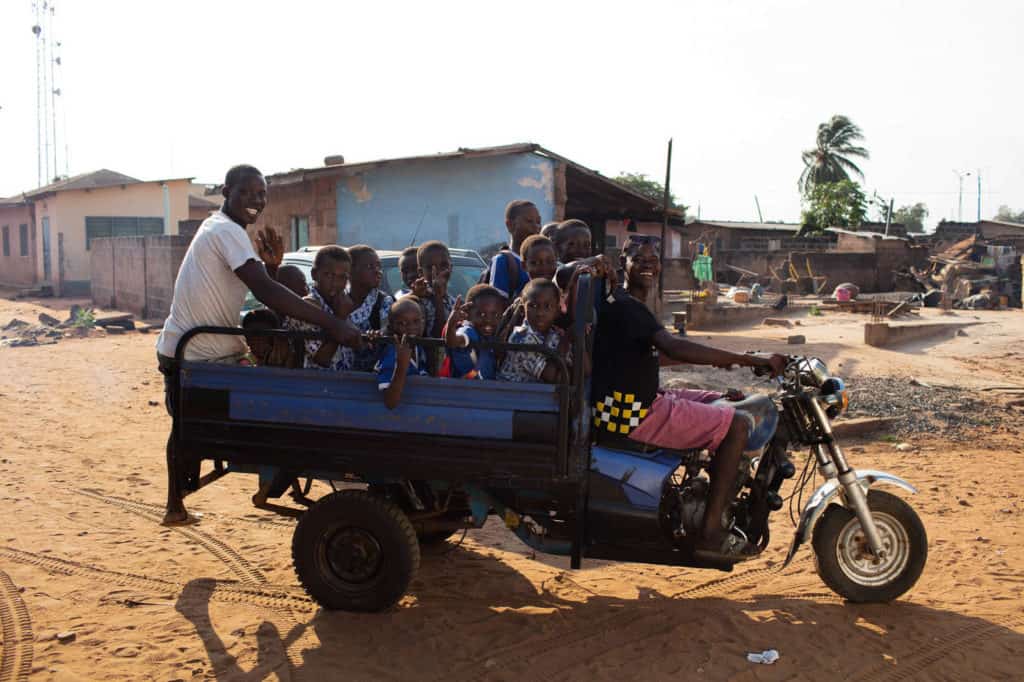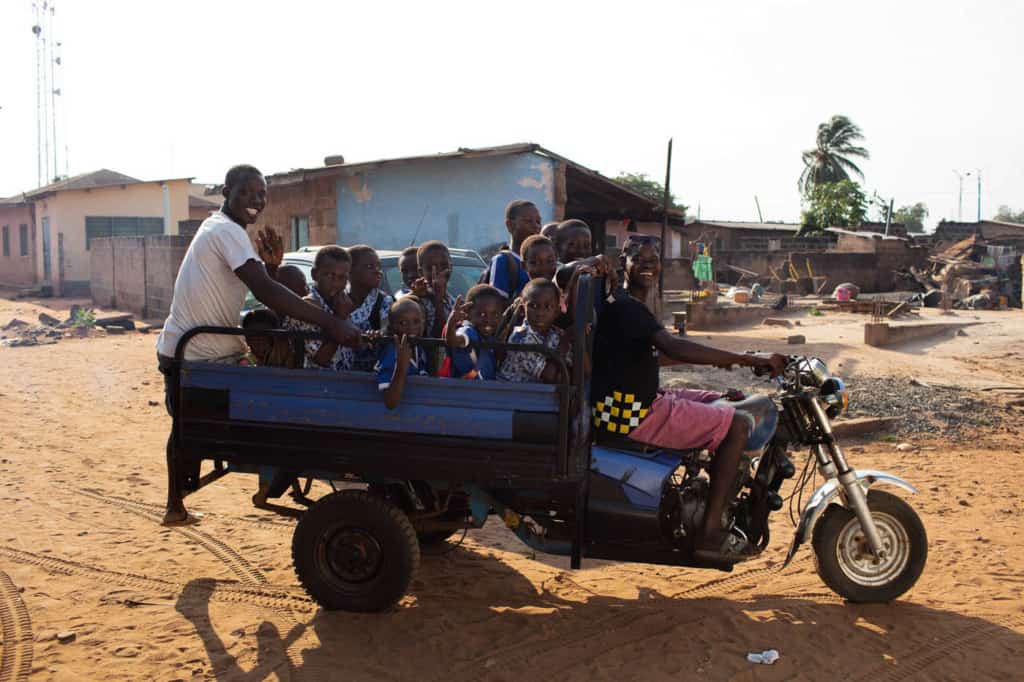
The Republic of Ghana is a bustling country found in West Africa between Cote d’Ivoire, Togo and Burkina Faso, and it borders the stunning Gulf of Guinea. Formally known as the Gold Coast, Ghana boasts great natural wealth and beauty, not to mention giant markets, colonial forts and a lively culture. From Lake Volta — the largest artificial reservoir in the world — to pristine coastlines, it is little wonder that Ghana is a popular tourist destination.
But in the midst of the beauty, child trafficking, violent gender discrimination and extreme poverty are prevalent. While many Ghanaians face challenges, there are reasons to hope and celebrate. Here are some fun facts about Ghana that will help you to understand the culture and traditions of this country where tens of thousands of precious Compassion-assisted children live.
Key Facts About Ghana
Here are some quick, interesting facts you should know about Ghana.
- Population: 29,340,248
- Capital: Accra
- Official language: English
- Area: 92,100 square miles, or a little larger than Minnesota
- Economy: Agriculture accounts for about 20% of its gross domestic product and employs more than half of the workforce. Gold, oil and cocoa exports are major sources of foreign exchange. The southern and urban areas of Ghana have a medium standard of living while the northern and rural areas are characterized by malnutrition and extreme poverty.
Culture and Traditions of Ghana
Ghana’s friendly people and lively atmosphere have made it a popular destination. With vibrant festivals, beautiful art and unique culture, it is no wonder that the country is called “Africa’s capital of cool.” Let’s learn a little more about this nation!
Religion: The constitution provides for freedom of religion. About 20% of the population identifies as Muslim, while over 70% identifies as Christian. Many Christians and Muslims incorporate Indigenous beliefs into their religious practices.
Clothing: Although younger generations often dress in T-shirts and jeans, many Ghanaians take pride in wearing traditional clothing. “Kente,” a colorful, handwoven cloth with bold patterns, is used to create garments for both men and women. There are over 300 different patterns of kente — each with a unique name and symbolic meaning. Men traditionally wear a long smock over trousers. Women commonly wear a long skirt or dress and a short-sleeved top with a complementing head wrap.
General culture: While over 100 ethnic groups are present in Ghana, there are six main groups: the Akan (Ashanti and Fanti), the Ewe, the Ga-Adangbe, the Mole-Dagbani, the Guan and the Gurma. The Ashanti, the largest tribe in Ghana, are known for their hand-carved stools, fertility dolls and kente cloth. Although English is the official language, Twi, Fante, Ga, Hausa, Dagbani, Ewe and Nzema are also spoken. The language of Twi — spoken by the Akan — is rich with proverbs and euphemisms. Ghanaians value good manners, polite interaction and respect for family — especially the elderly.
Read about more about the culture of Ghana.
Music and Dance of Ghana
Ghana is the land of festivals, music and dance! From traditional folk music to lively modern tunes, music and dancing are found in every corner of Ghana.
Ethnic or traditional music is normally played during festivals, ceremonies, weddings and funerals. While the style varies by region, most traditional music is composed of singing, clapping and drumming. Stringed instruments, and gongs and drums are also played. Inseparable from traditional music are accompanying dances. The purposes of these dances are to greet gods and spirits or re-enact stories and legends, or simply for fun.
One popular genre of music in Ghana is known as “highlife.” A blend of jazz and Indigenous African styles, highlife is characterized by syncopated melodies and asymmetrical drum rhythms — derived from traditional drumming practices. Lyrics are sung either in Yoruba or English, but Western instruments are used.
Choral music is also popular in Ghana. It is often performed in concert halls, churches, schools and colleges. Because of the prevalence of Christianity, many choral songs are hymns to honor God.
Food and Drink of Ghana
Ghana’s cuisine is a mix of Indigenous, European, Indian and other foreign influences. Soups and stews are common dishes, and staple ingredients include cassava, plantain, millet, sorghum, yams, corn and beans. Here are a few delicious examples of what you could taste in Ghana.
Crispy yams, fried or baked, are a popular snack served by street vendors in Ghana. Yams are a nutritious choice packed with vitamin C, potassium and fiber. Learn to make your own crispy yams!
Fufu — Ghana’s national dish — is made from pounding cassava and unripe plantains into a starchy side dish. Fufu is challenging to make and often takes two people — one pounding the dough and one moving it around. However, the resulting dumpling is a great addition to soups and sauces.
Palm nut soup is a thick stew made from palm nut pulp, water, fish or meat, tomatoes, and onions and flavored with pepper, salt, garlic and chili peppers. It is best served with fufu for a hearty meal.
Sobolo is a delicious hibiscus tea with a deep red color. Sugar is added, and the drink is typically served cold. Not only is sobolo a refreshing beverage, but it also provides health benefits like lowering blood pressure and cholesterol levels.
A Story From Ghana: A “Curse” Destroyed by Truth and Love
Sabina was a young, healthy girl who never went out of the house. The reason? She is a 10th-born child.
In Sabina’s community in Ghana, traditional superstitions are closely held, and one of them is that 10th-born children are cursed. Without a ritual cleansing, which was too expensive for Sabina’s family, she was forbidden to go into public places for fear of attack by spirits. Sabina’s mother, Felicia, was rooted in traditional worship and feared for her daughter’s life.
Thankfully, Sabina’s father, Joseph, didn’t believe his daughter was cursed. He had given up ancestral taboos and become a member of the local church. When the church partnered with Compassion to start a child development center, Joseph did not hesitate to register Sabina. However, he soon left for a job in another town, and Felicia refused to let her daughter attend center activities.
Although Felicia went to great lengths to avoid them, the center’s staff members were determined to meet with her. Center Director Emmanuel Kuma says, “We knew that this was a battle for a soul, and every soul is important to God, so we had to fight for Sabina. Beyond that, Compassion is an advocate for children. We are protecting them, we are developing them, giving them dignity and integrity. Why should Sabina be left out when we could help her?”
Finally, Felicia decided to visit the church, where she spoke with the pastor about Sabina attending the center. She agreed to let Sabina attend, and now she believes in the power of prayer. Felicia says she knows the prayers of the pastors are protecting Sabina. She allows her daughter to leave the house, not only for the center but also for school and church. And as Felicia’s belief in superstitions fades, Sabina’s enthusiasm for life grows. “I am always happy when I go to school and the center, because I no longer have to stay in the house. Our teachers tell us stories from the Bible, and they give us delicious food to eat at the center,” she says.
BONUS: Fun Fact About Ghana
Although native to South America, cocoa beans are primarily produced in West Africa. Ghana may have a small land area, but it is the second-largest exporter of cocoa beans in the world.
Photos of What Daily Life is Like in Ghana
Do you want to keep learning about the beautiful country of Ghana?
Facts About Compassion and Ghana ›
Each week on the blog, we’re posting an article of facts about a different country where sponsored children live. Keep an eye out for the countries that interest you the most!

